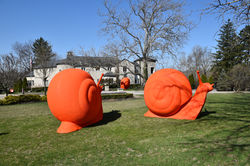Three larger-than-life snails adorn the front lawn of the Dublin Arts Council building located at 7125 Riverside Drive, Dublin, OH, USA. The artworks traveled from Milan, Italy where they were created by a group of six Italian-based artists known as Cracking Art. Formed in 1993, Cracking Art Group upholds a solid commitment to investigating social and environmental issues through the conception and creation of art.
Dublin Arts Council grounds will serve as the initial site and home for the snails, with the intention that the snails will travel to additional sites in the community. Through programming inspired by the concept of the snail, the Dublin Arts Council will invite the community to meet the snails in person and explore related themes. DAC will gather input from the community, encouraging those who live, work, visit, learn and play in Dublin to help build the snails’ story and journey.
Public Art is a conversation that sparks curiosity, creates meaning, and includes many voices. During the exhibition, the Dublin Arts Council gallery will be activated with creative prompts, sensory activities and contemplative practices inspired by the nature of snails.
Rotational Molding
Rotational molding is a process that can create large and small seamless hollow plastic forms. The manufacturing process is used in producing playground equipment such as Little Tikes, Step 2, kayaks, storage tanks, planters, and more.
The process entails using a thin-walled hollow metal mold and placing polymer powder (plastic) inside the mold. Heat is applied to the exterior of the mold as the mold is rotated. The polymer powder melts and coats the interior wall of the mold as it rotates. The mold is cooled until the polymer hardens and the seamless hollow plastic part is removed.
The philosophy of Cracking Art:
“Choosing plastic as the material for the creation of artworks, the first intention of the movement was to associate its activity with a clear message of recycling. The plastic used for our urban artistic installations and sculptures has properties of virtual eternal power and can be crushed and reshaped into other sculptures. A real cycle of life to affirm that in Art, as in nature, nothing is created and nothing is destroyed. But everything changes, renews and regenerates.” — Cracking Art
Why Snails?
According to Cracking Art, the snail is one of the most meaningful animals thanks to its regenerative properties that symbolize rebirth and improvement. The snail moves slowly and patiently, representing the importance of moving gradually and safely toward a target. Its “home,” or shell, is not only associated with domesticity but also with mass communication in Italy, as the Italian word for snail – chiocciola – is also the name used for the @ symbol. The helix of its shell, which allows the snail to both hear and move, emphasizes the importance of the ability to listen and the utility of the upward movement that regulates the universe.
“We were inspired by the themes of the snails and curious about the way they exist in the world. The snails inspire us to think about our own relationship with nature and the way we show up in the world,” says Ava Morgan, Public Arts Manager at Dublin Arts Council.
Why Orange?
Because of its association with the changing seasons, the color orange can represent change and movement. Orange is also strongly associated with creativity, health and vitality.
The snail's journey...
 Snails arrive at Dublin Arts Council! |  The first glance... |  Look at that orange! |
|---|---|---|
 The Italian word for snail – chiocciola – is also the name used for the @ symbol. |  Happy orange snail! |  Larger than life... |
 Snail pair in the lawn |  Orange is the happiest color! |








